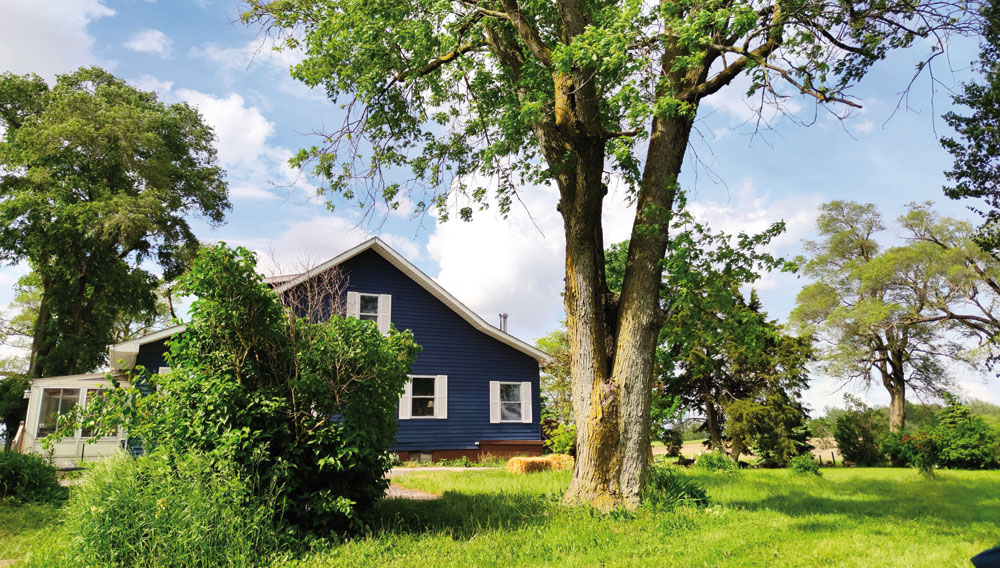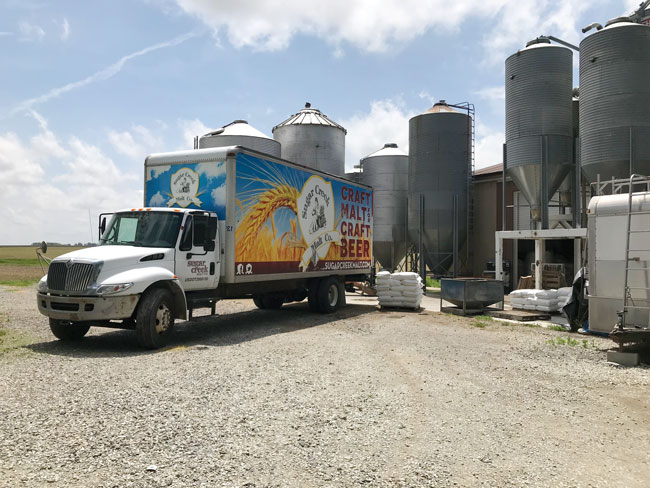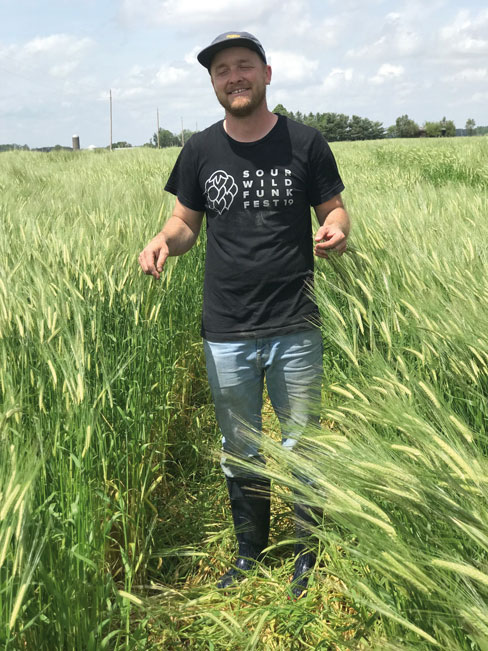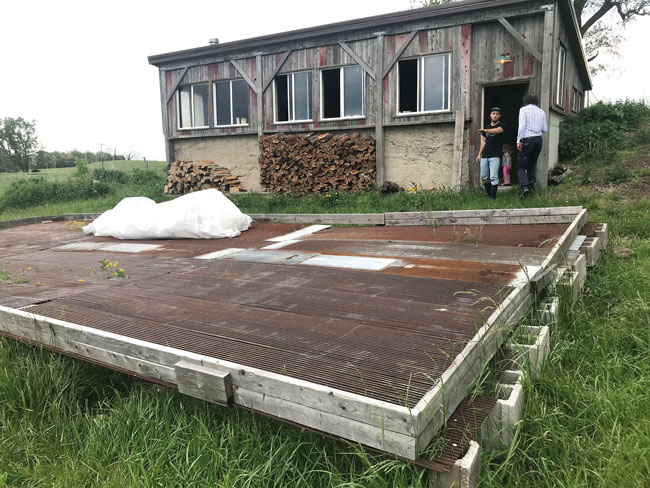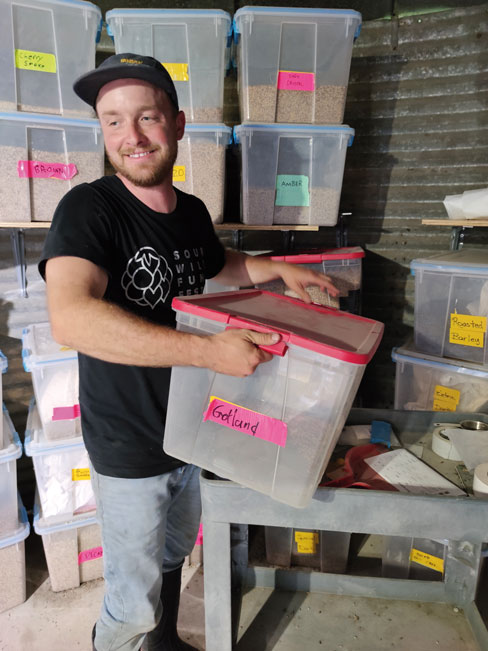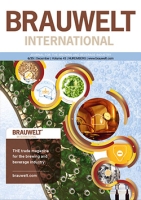Pioneering work in the field and in the kiln: micromalting in the USA
Quality and innovation | Sugar Creek Malt is an outstanding example of a craft malting facility where the maltsters are resolved to make a product exhibiting true value through a combination of stamina and conviction. BRAUWELT author Sylvia Kopp visited the micro-malthouse in the US state of Indiana where she met the founder who is as down-to-earth as he is creative. In the eight years of its existence, the malthouse has enriched the brewing industry with its innovative approach.
The landscapes of Boon County in Indiana are not for those seeking a romantic getaway. The farmland of gently rolling plains extends as far as the eye can see. The fields of grain are only sporadically interrupted by a lone hedge or a line of trees. Isolated farms, connected by narrow farm-to-market roads, look like toy houses randomly scattered across the terrain by the relentless gusts of wind. After a long drive, there it stands, rising out of the grassland as if in defiance of the incessantly blustery weather: the Sugar Creek Farm and Craft Malthouse. Founded in 2014 by Caleb Michalke and Whitney Galvin-Michalke, around 500 tons of grain are malted there annually, equivalent to the amount a large malthouse might produce in a single day. Their slogan is: “Locally Grown. Hand Crafted. Malt.” Although much of the American craft beer movement draws on descriptors, such as “regional” and “handcrafted”, these words are not thrown around lightly at Sugar Creek Malt.
The malting process starts with “locally grown”. Caleb drives me out to his barley fields in his truck. The Michalke family farms about 550 acres of land. He notes that corn and soybeans are the leading crops cultivated in Indiana. They are low-maintenance, produce high yields and are subsidized by the government. “Idiot-proof, so to speak,” adds Michalke. Barley, on the other hand, is not planted in his region at all. In fact, the Michalkes are the first farmers to grow barley in Indiana since Prohibition (1920–1933). According to Michalke, the majority of the barley acreage is located in the northern states of North Dakota, Montana and Idaho. In these states, the fields are almost exclusively devoted to the cultivation of malting barley (rather than feed barley, since domestic corn and soybean production already satisfies the required volumes of animal feed at a lower cost). As a result, the barley varieties available to US farmers are tailored to northern growing conditions. “In Indiana, we have a different climate, which is not optimal. It’s much wetter here,” he says. In order to compensate for unfavorable climatic conditions, he selects the best fields for planting well in advance. From sowing to harvesting and storage, this grain is very particular. Barley has to have the proper (low) protein content and must be carefully harvested under the driest conditions possible. “It’s time-consuming,” explains Michalke, “much more so than corn or soybeans.”
To meet demand and to be ready to react to possible crop fluctuations, he contracts neighboring farmers every year to cultivate malting barley. However, since they do not have extensive experience in growing barley, Michalke supervises them very closely. In poor crop years, when the quality requirements are not met, he sources barley from Kentucky. It’s May. His two-rowed malting barley is knee-high, green and stands strong in the field. We drive another kilometer. There, we survey a field planted with a historic two-rowed winter barley variety, now waist-high on long, flexible stalks. Michalke has grown up this variety from a 200-gram seed packet within a four-year period. This barley is a descendent of the variety Hana, a Moravian landrace, which he employs to produce his “Edelweiss Old World Czech Style Lager Malt”. According to Michalke, it is an under-modified malt, not suitable for infusion mashing. Instead, he recommends a decoction process.
DIY design
As with sourcing the raw materials, small-batch malting is pioneering. “Starting a craft malting plant was like being in the Wild West,” says Michalke. “A lack of information, no equipment and hardly any people to ask for advice.” As he tells it, 80 percent of the world’s malt is produced by just ten corporations – enormous companies with many locations. The remaining 20 percent comes from large maltsters, mostly from Europe; of these, only a few could be called craft maltsters, according to Michalke. These are in stark contrast to the approximately 150 craft maltsters in North America today. There were only a dozen in existence when Sugar Creek Malt was founded. Therefore, it is not surprising that there were no suppliers for small-scale malting plants at the time. “We looked everywhere. We only found suppliers in China and Germany, but because of the high logistics costs, it would never have been profitable to buy from them,” he says. Out of necessity, they found equipment from other industries and converted it to serve their needs. For example, they use a conical 3000-liter tank from a syrup refinery as a steeping vessel. Germination takes place in a pneumatic system in which air with controlled humidity and temperature flows through the steeping grain. Their kiln was designed and made by them.
As far as the craft of malting is concerned, an advanced training course in Canada provided the necessary basic knowledge. As for the rest: “well, it’s been trial and error, and we’ve grown with every mistake,” reveals Michalke. Unlike brewing or distilling, there are hardly any resources for malting that provide instructions or information on processes. The Michalke family had to figure it all out themselves. “Every year, we have to learn anew how to malt our grain. Since we work with a natural, living raw material, it always turns out differently,” he explains. Skilled workers don’t exist either. The malthouse has to train its own employees. “And malt quality is not that simple,” points out Michalke. “You can’t just judge it simply on the basis of flavor and color.” Achieving the proper efficiency, diastatic power, beta-glucan and FAN content is not so easy... Michalke is glad a lab opened in New York a few years ago that can analyze all of their grain and malt. Still, he admits, “Having our own lab for immediate feedback would be a dream” – a dream with a $250,000 price tag. Be that as it may, in the meantime, he can say with a clear conscience: “In terms of quality and consistency, our malt rivals any malt in the world.”
The greatest advantage of small-scale maltsters is their creativity: initially, Sugar Creek Malt produced European-style malts. Then they acquired a cold smoker. “We have the world’s largest selection of smoked malts,” says Michalke proudly. There are 40 different wood-, barrel-, herb- and peat-smoked varieties to choose from, including those smoked with apricot wood, which imparts a fruity-sweet, earthy and nutty aroma, rum barrel-smoked malt with notes of toffee, honey and Caribbean spices, and malt smoked with sage, which gives the malt both a minty spiciness and oatmeal-like aromas. They have also expanded their range to encompass malts made from rare grains, such as ancient corn and rice varieties as well as sorghum and buckwheat. A malt roaster was purchased, and crystal and dark roasted malts were added to their product palette.
In 2019, the Michalke family converted their old barn into a Såinnhus, the only one in the United States. This is a miniature malthouse, like the ones farmhouse brewers in Norway have used communally for centuries. The one on the Michalke farm is very small. Upon entering, there is a germination floor about 40 square meters in size. The grain is soaked in a wooden trough before it is cast out over the floor. As it germinates, the grain is manually turned to cool it and to aerate it. Just beyond is a narrow room with a rectangular base about waist-high constructed of masonry. Wooden planks with tiny holes are placed on top of the base. The fireplace is on the floor beneath it. For kilning, the green malt is transferred to the planks. Heat and smoke rise through the holes in the wood, passing up through the malt.
The fire is traditionally prepared using alder wood in Norway, which is typical for the production of Nordic Stjørdal malt. Michalke employs various types of wood and has developed a long list of historic malts: in addition to Stjørdal malt, German smoked malt, Scottish peated malt and Polish grodziskie malt (wheat malt smoked with oak), there are also variations without smoke, such as a Russian kiln-dried rye malt, a lambic wind malt dried by the sun and wind, and an English diastatic brown malt dried over wood and straw. The latter, he said, was the original malt used to brew porter before the invention of the roasting drum. “This is a long-forgotten enzymatic base malt that is no longer available anywhere else,” Michalke says.
He never tires of talking about the positive effects of craft malt. If the beer produced in the US states of Indiana and Illinois, which amounts to 790 000 hl/a, were to be brewed only with grain cultivated in those two states, he calculates that around nine million USD would flow directly into the pockets of the region’s small family farms. Unfortunately, these farms in actual fact are fighting for their lives. “And that only takes into account the positive impact on agriculture,” Michalke continued. “Think about those regional companies dealing in agricultural machinery, logistics, packaging manufacturers, the construction industry, etc.”
The prices for craft malt are certainly higher than those for “big malt”, but converted to a glass of beer, this adds up to less than five cents. A nickel! He recommends that brewers immediately raise the price for a glass of their beer by 50 cents: “You have a story to tell about your product; you demonstrate commitment to the regional economy, and you get to make more money per glass” – a win-win situation for everyone!
Sugar Creek’s beer portfolio
We drive to the small town of Whitestown, about 25 km away. Moontown Brewing Company has refurbished a former school gymnasium to house their brewery, pub and restaurant. Co-owner and head brewer Cody Peczkowski worked at Gordon Biersch for many years, a national brewpub chain specializing in German beer styles. Therefore, Peczkowski knows his lagers. He purchases almost all of his malt from Sugar Creek. He’s also a reliable sparring partner for Michalke when it comes to quality issues. “Feedback from Cody and other brewers is important at an existential level,” Michalke stresses. “It’s the only way we can learn how to make the best malt.” Peczkowski pours us the beer he brewed for Moontown’s fourth anniversary: an American Heirloom Czech Lager. The beer was brewed with Sugar Creek Edelweiss malt. This beer is multi-faceted: naturally cloudy and amber-gold with a fine, long-lasting head. It has a grain-like aroma impression with a bit of bread and straw blended with herbal green hop notes. The beer is silky, exhibiting a well-balanced, readily perceptible bitterness countered by a light honey sweetness with a fresh, green bitterness in the finish.
Sugar Creek products find their way out of Indiana as well. Most breweries I visited on my trip to the US carry at least one beer brewed with Sugar Creek malt in their portfolio: Fonta Flora, a Farmhouse Brewery in North Carolina, regularly brews a Såinnhus smoked lager. And their “Bad Seed”, a beer inspired by kvass, is fermented with a mixed culture. Afterwards, it is aged on pollen and toasted sesame and poppy seeds. To brew the beer, Sugar Creek barley, wheat and smoked malts are mashed together with bagels. The Parleaux Beer Lab in New Orleans brews their Mexican Lager with Sugar Creek pilsner malt and Oaxacan green corn, a Mexican corn variety which the Michalkes cultivate themselves. Averie Swanson of Keeping Together in Chicago uses a lavender-smoked malt from Sugar Creek for one of her saisons. Scratch Brewing Company in Illinois works primarily with Sugar Creek – their Såinnhus Stein Beer is legendary.
Caleb Michalke also dabbled in home brewing himself. Growing up the son of a farmer, he studied agriculture in Europe. He became fascinated with farming at an early age and has become an avid maltster and innovator. “From the beginning, I didn’t want to limit myself to producing one raw material. It has always appealed to me to be creative,” he says. That’s why micro-malting isn’t the end of the line. The Michalke family want to expand and build a larger malting facility, combining it with a farmhouse brewery. He wants to remain focused on the region and to operate the malthouse and brewery in as self-sufficient a manner as possible.
In their own unique way, Sugar Creek Malt has contributed to the farmhouse brewing trend, which is encouraging start-ups around the world to actively shape not only their products but also the context and setting in which they are produced. We look forward to seeing where this will take
them!
Keywords
USA barley malt craft brewing company news maltsters
Authors
Sylvia Kopp
Source
BRAUWELT International 2, 2023, page 78-81

